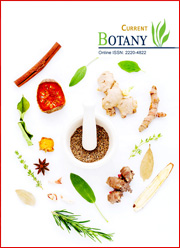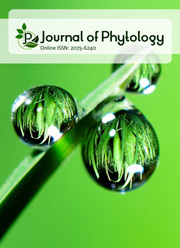Evaluation of Vermi-Derma bioformulations against blister blight disease of Camellia sinensis (L.) O. Kuntze
DOI:
https://doi.org/10.25081/cb.2025.v16.9454Keywords:
Tea, Camellia sinensis, Blister blight disease, Exobasidium vexans, Fungicides, Vermi-Derma, Biocontrol agentsAbstract
Blister blight disease caused by an obligate fungal pathogen, Exobasidium vexans is very common in almost all the tea growing regions in India. Due to this disease, the green leaf yield potential and tea quality parameters are significantly affected. In order to control this disease, several fungicide schedules are made available to tea planters. But the fungicide schedules lead to accumulation of fungicide residues in made tea which ultimately affect the export quality. Keeping in mind, studies were undertaken to evaluate the various concentrations of Vermi-derma bioformulations amended with various native biocontrol agents like Trichoderma harzianum (fungi), Pseudomonas fluorescens (bacteria) and Streptomyces sannanensis (actinomycete) against blister blight disease. The results revealed that there was a significant reduction in blister blight disease in the trail plots after imposing various treatments of Vermi-derma bioformulations. Among the treatments tested, a significant disease protection of 72.42±2.08% was registered with copper oxychloride + Contaf fungicides treatment. On the other hand, the highest green leaf yield of 5401±2.27 kg ha-1 made tea was registered with T. harzianum amended with Vermi-derma bioformulations (1:20 ratio) treatment. Similarly, biometric analysis, physiological traits and biochemical constituents were also increased in the same treatment. P. fluorescens and S. sannanensis amended with Vermi-derma bioformulations were found to be on par with each other in terms of disease control and green leaf yield. Increasing all these parameters might be due to the recovery of leaves from E. vexans infection by the action of Vermi-derma bioformulations.
Downloads
References
Anusuya, D., & Jayarajan, R. (1998). Solubilization of phosphorus by Trichoderma viride. Current Science, 74(5), 464-466.
AOAC. (1990). Estimation of various biochemical parameters. In K. Helrich (Ed.), Official Methods of Analysis of the Association of Official Analytical Chemists (15th ed., pp. 1552-1555). AOAC International: Gaithersburg, USA.
Baby, U. I., Balasubramanian, S., Ajay, D., & Premkumar, R. (2004). Effect of ergosterol biosynthesis inhibitors on blister blight disease, the tea plant and the quality of made tea. Crop Protection, 23(9), 795-800. https://doi.org/10.1016/j.cropro.2004.01.001
Bagyalakshmi, B., Ponmurugan, P., & Balamurugan, A. (2017). Potassium solubilization, plant growth promoting substances by potassium solubilizing bacteria (KSB) from southern Indian Tea plantation soil. Biocatalysis and Agricultural Biotechnology, 12, 116-124. https://doi.org/10.1016/j.bcab.2017.09.011
Balasubramanian, S., Netto, L. A., & Parathiraj, S. (2010). Unique graft combination of tea, Cr-6017/UPASI-9. Current Science, 98(11), 1508-1517.
Barman, A., Nath, A., & Thakur, D. (2020). Identification and characterization of fungi associated with blister blight lesions of tea (Camellia sinensis L. Kuntze) isolated from Meghalaya, India. Microbiological Research, 240, 126561. https://doi.org/10.1016/j.micres.2020.126561
Borthakur, B. K., & Dutta, P. K. (1992). Prospects of biocontrol of tea diseases in North East India. Proceedings of the 31st Tea Conference, Assam, India (pp. 163-168).
Bray, H. C., & Thorpe, W. V. (1954). Analysis of phenolic compounds of interest in metabolism. In D. Glick (Ed.), Methods of Biochemical Analysis (Vol. 1, pp. 27-52) New York, US: John Wiley & Sons. https://doi.org/10.1002/9780470110171.ch2
Chandramouli, B. (1992). Plant pathology. Annual Report of UPASI Scientific Department, 66, 93-114.
Chenniappan, C., Narayanasamy, M., Daniel, G. M., Ramaraj, G. B., Ponnusamy, P., Sekar, J., & Ramalingam, P. V. (2019). Biocontrol efficiency of native plant growth promoting rhizobacteria against rhizome rot disease of turmeric. Biological Control, 129, 55-64. https://doi.org/10.1016/j.biocontrol.2018.07.002
Chet, I. (1987). Trichoderma application, mode of action and potential as a biocontrol agent of soilborne plant pathogenic fungi. In I. Chet (Ed.), Innovative approaches to plant disease control (pp. 137-160). New York, US: John Wiley & Sons.
Dethoup, T., Klaram, R., Pankaew, T., & Jantasorn, A. (2022). Impact of fungicides and plant extracts on biocontrol agents and side-effects of Trichoderma spp. on rice growth. European Journal of Plant Pathology, 164, 567-582. https://doi.org/10.1007/s10658-022-02581-z
Do, Q. T. (2025). The endophytic bacterium Bacillus subtilis R8 as a prospective biocontrol agent for managing tea blister blight and enhancing tea yield. Biocontrol, 70, 379-390. https://doi.org/10.1007/s10526-025-10303-7
Dubois, M., Gills, K. A., Hamilton, J. K., Rebers, P. A., & Smith, F. (1956). Sugar estimation by phenol-sulphuric acid method. Analytical Chemistry, 26, 350.
Elad, Y., & Chet, I. (1983). Improved selective medium for isolation of Trichoderma or Fusarium spp. Phytoparasitica, 11, 55-58. https://doi.org/10.1007/BF02980712
Elango, V., Manjukarunambika, K., Ponmurugan, P., & Marimuthu, S. (2015). Evaluation of Streptomyces spp. for effective management of Poria hypolateritia causing red root-rot disease in tea plants. Biological Control, 89, 75-83. https://doi.org/10.1016/j.biocontrol.2015.05.003
Fauziah, F., Setiawati, M. R., Pranoto, E., Susilowati, D. N., & Rachmiati. Y. (2019). Effect of indigenous microbes on growth and blister blight disease of tea plant. Journal of Plant Protection Research, 59(4), 529-534. https://doi.org/10.24425/jppr.2019.131264
Gnanamangai, B. M., Ponmurugan, P., Jeeva, S. E., Manjukarunambika, K., Elango, V., Hemalatha, K., Kakati, J. P., Mohanraj, R., & Prathap, S. (2017). Biosynthesised silver and copper nanoformulation as foliar spray to control bird's eye spot disease in tea plantations. IET Nanobiotechnology, 11(8), 917-928. https://doi.org/10.1049/iet-nbt.2017.0023
Gomez, K. A., & Gomez, A. A. (1984). Statistical procedure for agricultural research (2nd ed.). New York, US: John Wiley & Sons.
Han, Y., Deng, X., Tong, H., & Chen, Y. (2024). Effect of blister blight disease caused by Exobasidium on tea quality. Food Chemistry, 21, 101077. https://doi.org/10.1016/j.fochx.2023.101077
Harborne, J. B. (1973). Phytochemical Methods: A guide to modern techniques of plant analysis. (3rd ed.). UK, London: Chapman and Hall.
Hazarika, S. N., Saikia, K., Borah, A., & Thakur, D. (2021). Prospecting endophytic bacteria endowed with plant growth promoting potential isolated from Camellia sinensis. Frontiers in Microbiology, 12, 738058. https://doi.org/10.3389/fmicb.2021.738058
Jayarajan, R., Ramakrishnan, G., Diwakaran, D., & Sridhar, R. (1994). Biotechnology in India (pp. 25-36). Valparai, Tamil Nadu, India: UPASI Tea Research Institute.
Ji, P., & Wilson, M. (2003). Enhancement of population size of a biological control agent and efficacy in control of bacterial speck of tomato through salicylate and ammonium sulfate amendments. Applied Environmental Microbiology, 69(2), 1290-1294. https://doi.org/10.1128/AEM.69.2.1290-1294.2003
Kalim, S., Luthra, Y. P., & Gandhi, S. K. (2000). Influence of Bavistin seed treatment on morphological and biochemical parameters of cow pea roots susceptible to Rhizoctonia species. Journal of Mycology and Plant Pathology, 30(3), 375-379.
Kuster, E., & Williams, S. T. (1964). Selection of media for isolation of Streptomyces. Nature, 202, 928-929. https://doi.org/ 0.1038/202928a0
Lowry, O. H., Rosebrough, N. J., Farr, L., & Randall, R. J. (1951). Protein measurement with the folin phenol reagent. Journal of Biological Chemistry, 193(1), 265-275.
Manivel, L., & Hussain, S. (1982). Photosynthesis in tea II: Direction of movement of photosynthates. Two Bud, 29, 49-52.
Manjukarunambika, K., Mandal, A. K. A., Balasubramanian, M. G., & Ponnusamy, P. (2023). Multifaceted plant growth-promoting traits of indigenous rhizospheric microbes against Phomopsis theae, a causal agent of stem canker in tea plants. World Journal of Microbiology and Biotechnology, 39(9), 237-242. https://doi.org/10.1007/s11274-023-03688-z
Moore, S., & Stein, W. H. (1948). Photometric ninhydrin method for use in the chromatography of amino acids. The Journal of biological chemistry, 176(1), 367-388. https://doi.org/10.1016/S0021-9258(18)51034-6
Nisha, S. N., Prabu, G., & Mandal, A. K. A. (2018). Biochemical and molecular studies on the resistance mechanisms in tea [Camellia sinensis (L.) O. Kuntze] against blister blight disease. Physiology and Molecular Biology of Plants, 24, 867-880.
Nithya, M., Ponmurugan, P., Gnanamangai, B. M., Robinson, J. P., Mathivanan, N., & Senthilkumar, J. (2020). Evaluation of different native Streptomyces spp. for effective management of rhizome rot of turmeric. Journal of Applied Botany and Food Quality, 93, 225-233.
Papavizas, G. C. (1985). Trichoderma and Gliocladium: biology, ecology and potential for biocontrol. Annual Review of Phytopathology, 23, 23-54. https://doi.org/10.1146/annurev.py.23.090185.000323
Ponmurugan, P., & Baby, U. I. (2007). Evaluation of fungicides and biocontrol agents against Phomopsis canker of tea under field condition. Australasian Journal of Plant Pathology, 36, 68-72. https://doi.org/10.1071/AP06084
Ponmurugan, P., Gnanamangai, M. B., & Manjukarunambika, K. (2019). Architectural effect of different tea clones on the development of blister blight disease. Journal of Applied Botany and Food Quality, 92, 7-14. https://doi.org/10.5073/JABFQ.2019.092.002
Ram, C. S. V., & Mouli, B. C. (1983). Interaction of dosage, spray interval and fungicide action in blister blight disease control in tea. Crop Protection, 2(1), 27-36. https://doi.org/10.1016/0261-2194(83)90023-6
Ramya, M., Ponmurugan, P., & Saravanan, D. (2013). Management of Cephaleuros parasiticus Karst (Trentepohliales: Trentepohliaceae), an algal pathogen of tea plant, Camellia sinensis (L) (O. Kuntze). Crop Protection, 44, 68-74. https://doi.org/10.1016/j.cropro.2012.10.023
Sadasivam, S., & Manickam, A. (1996). Biochemical methods. (2nd ed.). New Delhi, India: New age international Publishers.
Sanjay, R., Ponmurugan, P., & Baby, U.I. (2008). Evaluation of fungicides and biocontrol agents against grey blight disease of tea in the field. Crop Protection, 27(3-5), 689-694. https://doi.org/10.1016/j.cropro.2007.09.014
Sreenivasaprasad, S., & Manibhushanrao, K. (1990). Antagonistic potential of Gliocladium virens and Trichoderma longibrachiatum to phytopathogenic fungi. Mycopathologia, 109, 19-26. https://doi.org/10.1007/BF00437002
Suriyakumar, C. R. (2009). Vermicompost: technology, evaluation and enterprising. In P. Ponmurugan & B. Nithya (Eds.), Guidelines for Entrepreneurship development programme to Biotechnology graduates (pp. 31-38) New Delhi, India: Excel India Publishers.
Windham, M. T., Eland, Y., & Baker, R. (1986). A mechanism for increased plant growth induced by Trichoderma spp. Phytopathology, 76(5), 518-521.
Published
How to Cite
Issue
Section
Copyright (c) 2025 Sappanimuthu Parathiraj, Ponnusamy Ponmurugan, Devaraj Mounika, Arumugam Anitha, Siby Mathew

This work is licensed under a Creative Commons Attribution-NonCommercial 3.0 Unported License.



 .
.